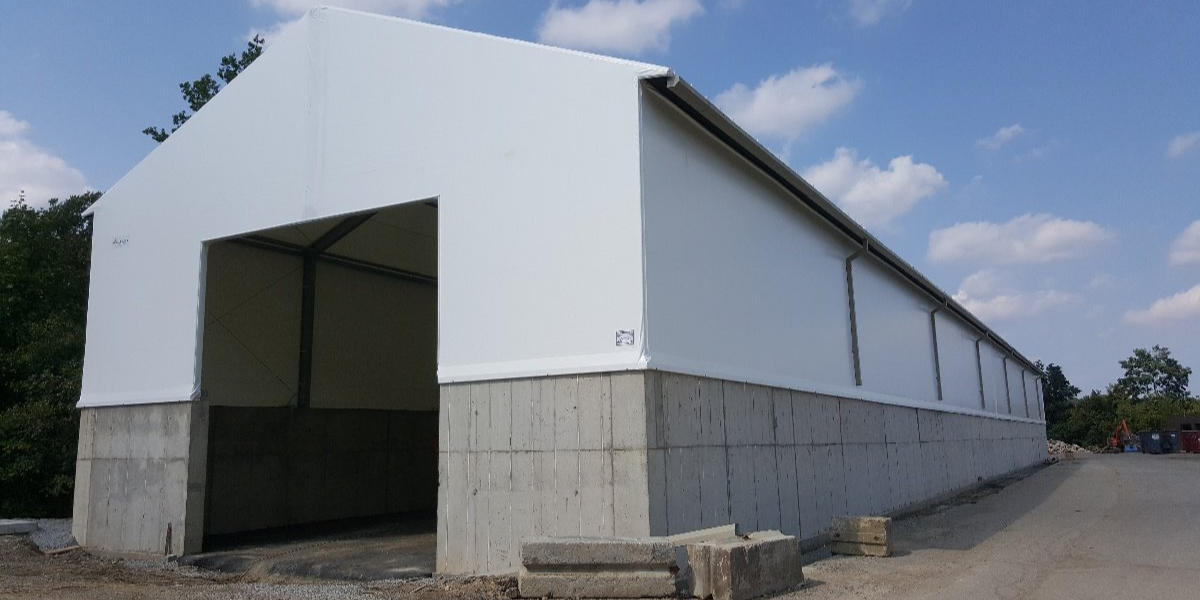Fabric Buildings vs Concrete Buildings

One of the most important decisions to make in a building project is what type of structure you will build. Directly comparing two building types will typically give the most accurate picture of the right building type for you.
Read on to learn more about how tension fabric buildings compare with concrete buildings.
How Fabric Buildings Compare to Concrete Buildings
Customization
"Tilt-up" concrete buildings are commonly used for big box stores and other industrial buildings. This type of concrete building is common because it can be installed more quickly than a custom concrete structure; however using these pre-made concrete walls means your building will look like a big box store.
Custom concrete buildings are available, however choosing one will add curing and drying time to your construction project (to say nothing of the additional engineering and design time). In contrast, fabric buildings can be completely custom built to your specifications with no added time or expense.
Fabric buildings are a great choice for retail applications. Click here for an example.
Natural Light
Tension fabric structures are well-known for their bright, sunlit interiors. Thick-walled concrete buildings simply can't replicate that. Adding doors, windows and skylights adds some sunlight into the building, but it's not a substitute for sunlight flooding in through the entire surface of the walls.
Roof Slope
Sloped roofs are a practical choice for stopping rain and snow build-up on your roof, and in some places sloped roof pitches are actually required to meet local building codes.
The roof slope helps buildings shed snow. Listen to a webinar to learn more.
The steel I-beams used in fabric buildings can be built in any shape, including peaked or monoslope roofs of any pitch. Heavy concrete is not as easy to manipulate into practical and attractive roof shapes, so adding a slope will definitely add cost to your project.
Future Maintenance
Concrete buildings are often sold as low- or no-maintenance structures. However, think of a concrete sidewalk - it's likely full of cracks and chips. A major disadvantage of concrete is that these chips and cracks are difficult and expensive to repair. While sidewalk slabs are fairly easy to replace, building walls are not.
Fabric is sturdy and long-lasting; in the event your fabric building is damaged it can be patched and repaired by the building owner or by trained crews.
Portability
Concrete buildings are engineered to be built in one place (after hauling heavy materials to that place) and stay there. While fabric buildings are certainly able to stand for decades and make great permanent structures, they are flexible enough to be relocated if needed.
If you are building on leased land, or you move to a new location someday, your fabric building can go with you. In addition, fabric buildings can also be expanded later on.
Insulation
Both concrete and fabric have advantages when it comes to staying warm in the winter and cool in the summer. And either type of building can be insulated for even more protection from the elements.
Here, fabric has the obvious advantage of additional sunlight. In addition, tension fabric structures are flexible enough to incorporate any type of ventilation system (active or passive) into the design of the building.
Learn more about the advantages of passive ventilation systems.
Doing research and talking to builders is one great way to learn more about how a particular building type can meet your needs. For more specifics about how a fabric building can work for you, contact us.
Subscribe to our Blog
Recent Posts
- 5 Factors Every Project Owner Should Consider Before Approving Building Materials
- The 20-Year View: How Material Choices Impact Long-Term Operational Costs
- Climate Resilience in Commercial Construction: Why Traditional Methods May Not Be Enough
- Speed and Quality: The Role of Hybrid Building Materials
- Beyond the Bleachers: Designing Visually Striking Sports Facilities
